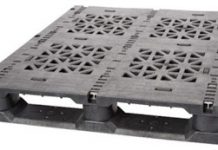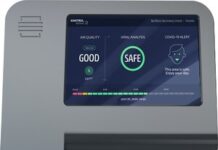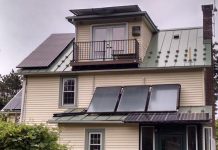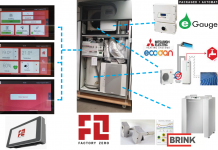Energy Efficiency breaks the laws of economics. Despite the fact that it’s considerably cheaper then traditional energy sources, as well as providing substantial benefits in terms of comfort, economic growth, safety, and the environment, barriers arising from misplaced incentives and the attitudes, awareness, perceptions, and general level of knowledge all conspire to prevent people from taking steps which would otherwise be extremely rewarding.
The key to better implementation of Energy Efficiency programs are programs to raise people’s interest or awareness. For instance, there is the example of how Woodstock Hydro found that their customers’ electricity usage dropped 15% and were more satisfied with their service when they were given real time information about their electricity usage as part of a Pay-as-you-go program.
A Sioux Center Success Story
Another example of how information and awareness motivated people to be more energy efficient was told to me at the 2007 Energy Star Summit by Ron Horstman, the former Municipal Utilities Energy Efficiency coordinator of Sioux Center, Iowa. Sioux Center achieved almost universal residential participation in that city’s energy efficiency program by using infrared images to make aware of their homes’ energy use personal. This is his (lightly edited) description of the outreach efforts:
In 1986, the City of Sioux Center was engaged in a comprehensive community-wide energy management program. One of the overall goals of this program was to use energy efficiency as an economic development tool. Because Sioux Center imported over 98% of the energy it used, every dollar spent on energy left the community. If even a small percentage of that money were retained in the community, it would have a noticeable impact on the economy.
One of the first steps and goals was to raise the energy awareness level of the entire community and to get their attention so that the programs would have high levels of participation and would produce significant results.
Infrared Photos Raise Awareness and Interest
We chose to use infrared Thermography technology [see last week’s article on an IR Imaging Stock] to raise the energy awareness level of everyone in the community. We took an infrared photo from the street side of every home and business in the community and enclosed the photo with each owner’s utility bill, along with an invitation to call my office for an explanation or interpretation of what the infrared photo depicted.
I was inundated with calls. The photos touched everyone on a personal level. Residents and business owners saw their buildings in a new way, and they wanted to know what it meant. When a customer called for more information, I would pull up my copy of their infrared photo and explain the prominent thermal features. I used the conversation to tell them that their home or business was a prime candidate for a class "A" energy audit. People signed up for energy audits right and left and I conducted these audits as quickly as possible.
The utility had decided to offer these quality audits at a discounted price with the goal of educating each and every customer who decided to have the audit done. We only charged $10 for an audit valued at approximately $250. The information provided in each audit gave the building owners the information needed to allow them to make sound energy management decisions. The audit results sheet provided a list of energy efficiency measures each owner could implement, the cost of installation for each measure, the first-year savings of each measure, and the simple payback in years. This results sheet provided each recipient with a multi-year road map to energy efficiency. I conducted audits on 28% of the homes and businesses in the community.
Greatly Improved Participation in Future Programs
This one program built a great deal of credibility with our customers. Homeowners and business owners implemented the recommended energy efficiency measures from the audits and began to realize the savings. After that successful program, we initiated many other energy efficiency programs. All of the programs were successful to different degrees. The most important factor was the level of participation we were able to achieve with each program. One program in particular – the voluntary load management program – achieved 98% participation. The average utility implementing a load management program was only able to realize participation rates between 10 and 30%. Our credibility with our customers spurred our success.
Economic Benefits
After several years of conducting energy efficiency programs, I conducted and economic analysis to determine the impact these programs were having on the community. The numbers were astounding! The energy consumption per capita had been reduced by 38%, with millions of dollars retained in the community. Businesses were growing and expanding, jobs were being created, amenities such as parks, recreation facilities, and cultural opportunities were increasing, and industries moved to the community for its quality of life.
Societal Benefits
To re-emphasize Ron’s point about increased quality of life, this article about a more recent program in Sioux Center highlights the retrofit of the city’s fire station. In addition to a less than 12 year payback, the firemen reported being more comfortable (which likely helped the city with retention), increased use of the facility’s classroom, and volunteer firemen spent more time in the facility readying the equipment for their next call, which contributed to the safety of everyone in the region. According to Ron, the firemen’s new pride in their facility was felt throughout the community.
Infrared Imaging Stock
I’m still reluctant to buy FLIR at the current prices (even more so since a reader pointed out the P/E I was using was off by a factor of 2.) Nevertheless, stories like these leave me more convinced that infrared imagery must have a large role to play in promoting adoption of demand-side management. It may come with more communities publishing energy use maps, like Haringey in the UK, or with Eco-Brokers selling energy efficient homes contrasting IR images of their home with IR images of other nearby homes on the market, or with utility programs like that in Sioux Center using infrared images to make energy use personal.
DISCLOSURE: Tom Konrad and his clients do not have positions in any of the securities mentioned here.
DISCLAIMER: The information and trades provided here are for informational purposes only and are not a solicitation to buy or sell any of these securities. Investing involves su
bstantial risk and you should evaluate your own risk levels before you make any investment. Past results are not an indication of future performance. Please take the time to read the full disclaimer here.









Tom,
Thanks very much for this pair of columns on IR imaging. I’ve been in the business for several years and you’ve helped me look at it in a whole new way. I live in a temperate region on the coast where the residential applications are a bit tricky to apply, so have focused on industrial/electrical/mechanical apps, but am always looking for ways to bring it to the table where energy efficiency is the issue. I’m always delighted to see pieces like this that enhance the credibility I’ve worked so hard to build up over the years.
Regards,
Scott Willits
Redwood Infrared
Arcata, CA
Thanks for you comments, Scott. Please distribute these articles, with attribution, to potential customers if you feel it will help your business.